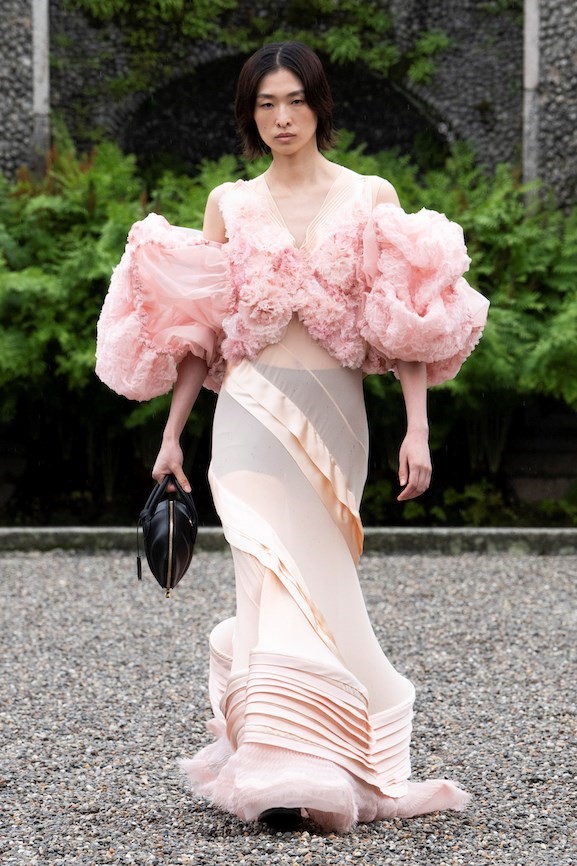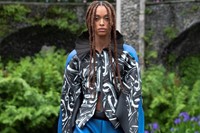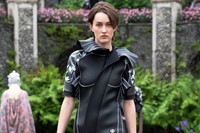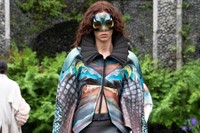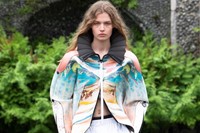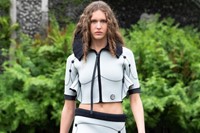Nicolas Ghesquière has always been fascinated by the otherworldly – even the outer-worldly. Star Wars has been a frequent reference, shaping his sci-fi silhouettes, the alien beauty of his clothes, his forward-thinking embrace of techno-fabrics and metallic finishes that bravely go where few garments have gone before. But, for his latest Louis Vuitton cruise collection, the otherworldliness seemed more mythological, age-honoured, ancient even. Ghesquière staged his show on Isola Bella, a tiny island on a northern Italian lake – formerly a rocky crag home to a simple fishing village, the spectacular island was built up by various scions of the aristocratic Borromeo family from the 17th century onwards, into a place renowned for its beauty across Europe. Nevertheless, in all that baroque there’s still Ghesquière’s beloved sci-fi link: the gardens were used as backdrop to some of Star Wars’ filming. So now you know.
They were originally intended to be the backdrop to this Louis Vuitton show too, but nature had other ideas: storms roiled across Lombardy and the entire Vuitton show was shifted from the parterre and terraces peppered with white peacocks to the grand interiors of the Palazzo Borromeo, stuccoed and frescoed and studded with masterpieces of art and grand Murano glass chandeliers. The models strode through enfilades of extraordinary rooms that had, famously, paid host to the likes of Napoleon and Joséphine, Caroline of Brunswick – the former Queen of England – and Ernest Hemingway. And their clothes kind of told the story of that telescoped history, too.
The mix in the clothes was dizzying, combining raiments seemingly pulled from the closets of the Borromeo lineage across the centuries with hyper-modern aquatic gear (plenty of wetsuits, clinging knits that seemed dampened against the body), a few headpieces straight out of Farinelli, scuba tailcoats hand-painted with scenes like the walls of baroque grottos. Everything and nothing made sense, which was kind of the point on this magical mystery tour through time and landscape. “The juxtaposition between the familiar and the remarkable,” was how Ghesquière described the melange. It’s part and parcel of his modus operandi at Louis Vuitton, closing in on a decade long – his way of dissecting almost two centuries of Vuitton’s legacy (it turns 170 next year, when this cruise collection drops) and finding a modernity in the past. And Vuitton’s history was, predominantly, about travel rather than fashion – although clothes filled the trunks, Vuitton gained his repute by both manufacturing and expertly packing back in the 19th century, so unpacking their contents is a natural exploration of the brand’s ethos.
Travel, then, is at the root of everything Ghesquière does. That said, his trip for this show was beneath the sea, rather than the traditional around-the-world inspiration drawn from cruise shows staged in exotic locales – or, indeed, the out-of-this-world ideals he often proffers in his shows. His clothes were inspired by the notion of the subterranean, of mermaids adorned with clothes of multiple eras swirled together, dredged up from the deep, extraordinary in their fusion of styles and in the odd adaptations engineered by their habitat: webbed sleeves, webbed pleats, embroideries of water droplets, fusions of fluidity and rigidity.
“Transformation” was the word Ghesquière used before the show. “That narrative follows a thread from the first hybrid looks, of neoprene ensembles and urban cuts that are like amphibious silhouettes, to the finale.” And that finale was a gorgeous array of bias-cut organza and satin dresses, flowing and flowering around the models’ bodies like undersea plants trembling in the current. “They’re like unreal flowers from this once-in-a-lifetime garden,” said Ghesquière. “Gravity-defying.” Which, come to think of it, is pretty Star Wars – even with a puff sleeve.
